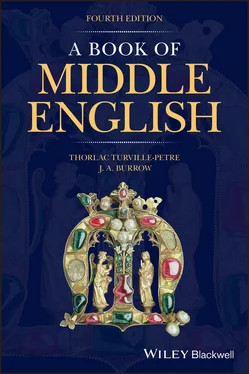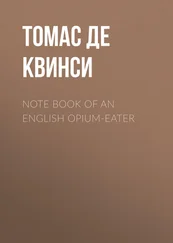As in Modern English, the ‘declarative question’, in which the word‐order is that of a statement, is also possible. Here the context, and in this particular case the addition of the adverbial clause, make it clear that this is a question: thow art broke, so may be? , ‘you are injured, maybe?’, 7a/33.
A negative question has verb–subject word‐order with ne before the verb: why ne dyʒttez þou me to diʒe? , ‘why don’t you condemn me to die?’, 8/488; nas I a paynym? , ‘was I not a pagan?’, 11/285.
The word whether may be used to introduce a question, especially if there is doubt between two alternatives: wheþer ys ʒow levere have …, ‘would you rather have’ (where the choice is between rhyme or prose), 12/145.
5.9 Word‐Order
5.9.1 Inversion
As in Old English and in Modern English, the usual word‐order of a statement in Middle English was subject–verb–object. Because Middle English has fewer inflexions to mark the function of words in a sentence, there is less variation of standard patterns than in Old English, though writers of verse had more freedom than prose writers to alter the word‐order for stylistic or metrical effects, provided the relationship between the words was clear from grammatical form or context. Most instances cited here to show standard patterns are therefore taken from the prose texts.
Inversion, where the subject follows the verb, is found particularly in the following circumstances, some of which have been discussed already:
1 In questions (see 5.8).
2 In commands and wishes: construe þou cleerly, 6/126; see who bi grace see may, 6/74. (See 5.6.6.)
3 In conditional or concessive clauses introduced by al, ‘although’, or without a conjunction (see 5.6.6), including hypothetical sentences containing never so: be þeo neode never so gret, ‘however great the need is’, 12/9.
4 Often after an adverb or phrase of place, time, manner etc.: here liþ counforte, ‘here lies comfort’, 6/125–6; for ever schal he do it, and never schal he seese for to do it, 6/73–4; riʒt wel hast þou seide, 6/113; and so þarynne ys noble and gret informacion and lore, 12/27–8; on al þis yvele time heold Martin abbot his abbotrice, 1/56. In a correlative construction, most frequent in Early Middle English, the inverted word‐order is used in the main clause. Common correlatives are þa … þa, ‘when … then’, or so … so: þa þe king Stephne to Englaland com, þa macod he his gadering, ‘when King Stephen came to England, (then) he held his council’, 1/5–6; þa he hafden al his iweden, þa leop he on his steden, ‘when he had all his gear, (then) he leapt on his steed’, 3/25. The inversion in the main clause is a useful indication that þa is an adverb, ‘then’, not a conjunction, ‘when’.
5 After an adverbial phrase that has been fronted for emphasis: by love may he be getyn, ‘he may be reached by love’, 6/222.
6 In negative statements with ne, particularly in early verse: ne kep ich noʒt, ‘I don’t care’, 2/154; ne schaltu nevre, 2/209 (see 5.7).
7 After there, where there is used as a dummy subject: þer ys moche Latyn in þeus bokes, 12/47. Earlier it was used in place of there: it nis no bot, ‘there is no remedy’, 5/552. Sometimes, especially in early texts, there is no dummy subject: wes nævre gæt mare wreccehed on land, ‘there was never before more misery in the land’, 1/43.
A pronoun object often precedes the verb, its inflected form determining its relationship: þe biscopes and lered men heom cursede ævre , 1/50–1. The same order is possible with a noun object, and even a noun object with a relative clause, as lordes here: that sche þe lordes ate feste / That were obeissant to his heste / Mai knowe , ‘so that at the feast she may get to know the lords who were subject to him’, 13/103–5.
In verse, and particularly in alliterative verse, prepositions may follow the noun or pronoun: þe peple biforne , ‘in front of the people’, 9/123; him barones besyde , ‘barons beside him’, 11/142. Deferred prepositions at the end of relative or infinitive clauses, of the type þe prik þat he schoteþ to , 6/199–200, can be brought forward, especially in verse: þe werst piler on to biholde , ‘the worst pillar to look at’, 5/367; this present to plese with Honger , ‘this present to please Hunger with’, 7b/318.
A relative þat ‐clause is quite often separated from the antecedent to which it refers, and this can cause difficulty since it is not possible in Modern English. In he shal have my soule þat alle soules made , 7b/96, it is obvious enough that the antecedent of the þat ‐clause is he and not my soule , ‘he who made all souls shall have my soul’. Less obviously, al studied þat þer stod , 9/237, is ‘all those who were standing there looked intently’, not ‘all looked intently at the one who stood there’, though it is only the context that determines it; and þe man marred on þe molde þat moʒt hym not hyde , 8/479, makes better sense as ‘the man who could not shelter himself suffered on the bare earth’, than as ‘the man suffered on the bare earth that could not shelter him’.
The position of adverbial phrases is very flexible, and they may even be placed outside the clause to which they belong: in worlde quat weghe þou was , ‘what man you were in the world’, 11/186. This is especially characteristic of Gower: wiþ al his herte and most it hateþ , ‘and most hates it with all his heart’, 13/56; wiþinne his herte and tok a pride , ‘and grew proud in his heart’, 13/135.
5.9.6 Verb in Final Position
A common word‐order is for the verb to come at the end of a subordinate clause, particularly in verse: Ne schaltu nevre so him queme / þat he for þe fals dom deme , 2/209–10; þis watz kynges countenaunce where he in court were , 9/100.
5.10 Recapitulation and Anticipation
A pronoun may recapitulate or anticipate a clause or a noun phrase. There are some good examples of this in Piers Plowman . In prestes and oþer peple towarde Peres they drowe , 7b/190, they stands for the noun phrase which is separated from its verb. In meschef hit maketh they ben so meke , 7b/212, hit anticipates the clause that follows. In ho‐so beste wrouhte / He sholde be huyred , 7b/120–1, He sums up the preceding clause ‘whoever did best’, and the same structure is seen in þat was bake for Bayard hit may be here bote , ‘what was baked for Bayard, (it) may be their salvation’, 7b/178. In alle þat grat in thy gate for Godes love aftur fode / Part with hem of thy payne , 7b/284–5, the inflected form hem both sums up the clause of l. 284 and establishes its dependence on Part with . The same structure, again with an imperative verb, is illustrated from the York Play: this traitoure here teynted of treasoune / Gose faste and fette hym , 15/77–8.
Two distinct metrical traditions are represented in this book: rhymed verse and alliterative verse. The verse of French and Anglo‐Norman poets was the chief model for the former; the history of alliterative verse is less clear, but it is a verse‐form native to Germanic peoples and used by the Anglo‐Saxons. English rhymed verse is based on the regular alternation of stressed and unstressed syllables; alliterative verse is based on stress and is syllabically variable.
Читать дальше












